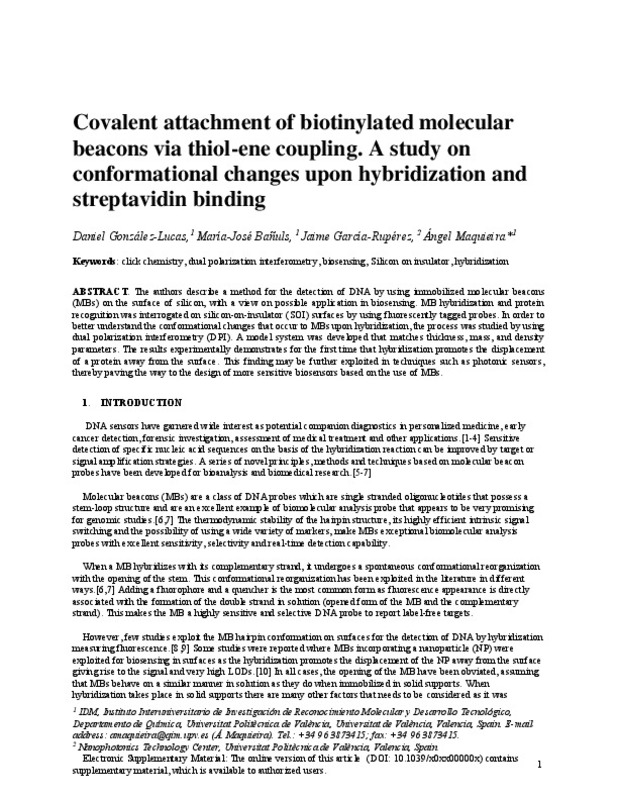Huertas CS, Fariña D, Lechuga LM (2016) Direct and label-free quantification of micro-RNA-181a at Attomolar level in complex media using a Nanophotonic biosensor. ACS Sensors 1(6):748–756
Bañuls M-J, González-Pedro V, Barrios CA, Puchades R, Maquieira Á (2010) Selective chemical modification of silicon nitride/silicon oxide nanostructures to develop label-free biosensors. Biosens Bioelectron 25(6):1460–1466
Zhang G-J, Chua JH, Chee R-E, Agarwal A, Wong SM (2009) Label-free direct detection of MiRNAs with silicon nanowire biosensors. Biosens Bioelectron 24(8):2504–2508
[+]
Huertas CS, Fariña D, Lechuga LM (2016) Direct and label-free quantification of micro-RNA-181a at Attomolar level in complex media using a Nanophotonic biosensor. ACS Sensors 1(6):748–756
Bañuls M-J, González-Pedro V, Barrios CA, Puchades R, Maquieira Á (2010) Selective chemical modification of silicon nitride/silicon oxide nanostructures to develop label-free biosensors. Biosens Bioelectron 25(6):1460–1466
Zhang G-J, Chua JH, Chee R-E, Agarwal A, Wong SM (2009) Label-free direct detection of MiRNAs with silicon nanowire biosensors. Biosens Bioelectron 24(8):2504–2508
Sassolas A, Leca-Bouvier BD, Blum LJ (2008) DNA biosensors and microarrays. Chem Rev 108(1):109–139
Chen T, Tan W (2013) Molecular beacons on solid surfaces. In: Yang CJ, Tan W (eds) Molecular Beacons. Springer, Berlin Heidelberg, pp 75–90
Wang K, Tang Z, Yang CJ, Kim Y, Fang X, Li W, Wu Y, Medley CD, Cao Z, Li J, Colon P, Lin H, Tan W (2009) Molecular engineering of DNA: molecular beacons. Angew Chem Int Ed 48(5):856–870
Zheng J, Yang R, Shi M, Wu C, Fang X, Li Y, Li J, Tan W (2015) Rationally designed molecular beacons for bioanalytical and biomedical applications. Chem Soc Rev 44(10):3036–3055
Guo Q, Bai Z, Liu Y, Sun Q (2016) A molecular beacon microarray based on a quantum dot label for detecting single nucleotide polymorphisms. Biosens Bioelectron 77:107–110
Mei Z, Tang L (2016) Surface plasmon coupled fluorescence enhancement based on ordered gold nanorod array biochip for ultra-sensitive DNA analysis. Anal Chem 89(1):633–639
Li S, Wang Y, Gao C, Ge S, Yu J, Yan M (2015) “Signal-off” photoelectrochemical DNA sensing strategy based on target dependent DNA probe conformational conversion using CdS quantum dots sensitized TiO2 nanorods array as photoactive material. J Electroanal Chem 759:38–45
Escorihuela J, Bañuls M-J, Grijalvo S, Eritja R, Puchades R, Maquieira Á (2014) Direct covalent attachment of DNA microarrays by rapid thiol–Ene “click” chemistry. Bioconjug Chem 25(3):618–627
Yao G, Tan W (2004) Molecular-beacon-based array for sensitive DNA analysis. Anal Biochem 331(2):216–223
Du H, Strohsahl CM, Camera J, Miller BL, Krauss TD (2005) Sensitivity and specificity of metal surface-immobilized “molecular beacon” biosensors. J Am Chem Soc 127(21):7932–7940
Escorihuela J, Banuls MJ, Puchades R, Maquieira A (2012) DNA microarrays on silicon surfaces through thiol-ene chemistry. Chem Commun 48(15):2116–2118
Zhao W-W, Wang J, Xu J-J, Chen H-Y (2011) Energy transfer between CdS quantum dots and au nanoparticles in photoelectrochemical detection. Chem Commun 47(39):10990–10992
Bayer EA, Wilchek M (1990) Biotin-binding proteins: overview and prospects. In: Meir W, Edward AB (eds) Methods in enzymology, vol 184. pp 49–51
Escorihuela J, González-Martínez MÁ, López-Paz JL, Puchades R, Maquieira Á, Gimenez-Romero D (2015) Dual-polarization interferometry: a novel technique to light up the nanomolecular world. Chem Rev 115(1):265–294
Mira D, Llorente R, Morais S, Puchades R, Maquieira A, Marti J (2004) High-throughput screening of surface-enhanced fluorescence on industrial standard digital recording media. In: Proc. SPIE, pp 364–373
Volcke C, Gandhiraman RP, Gubala V, Doyle C, Fonder G, Thiry PA, Cafolla AA, James B, Williams DE (2010) Plasma functionalization of AFM tips for measurement of chemical interactions. J Colloid Interface Sci 348(2):322–328
Georgiadis R, Peterlinz KP, Peterson AW (2000) Quantitative measurements and modeling of kinetics in nucleic acid monolayer films using SPR spectroscopy. J Am Chem Soc 122(13):3166–3173
Elhadj S, Singh G, Saraf RF (2004) Optical properties of an immobilized DNA monolayer from 255 to 700 nm. Langmuir 20(13):5539–5543
Xu K, Ouberai MM, Welland ME (2013) A comprehensive study of lysozyme adsorption using dual polarization interferometry and quartz crystal microbalance with dissipation. Biomaterials 34(5):1461–1470
Cowsill BJ, Coffey PD, Yaseen M, Waigh TA, Freeman NJ, Lu JR (2011) Measurement of the thickness of ultra-thin adsorbed globular protein layers with dual-polarisation interferometry: a comparison with neutron reflectivity. Soft Matter 7(16):7223–7230
[-]







![[Cerrado]](/themes/UPV/images/candado.png)


